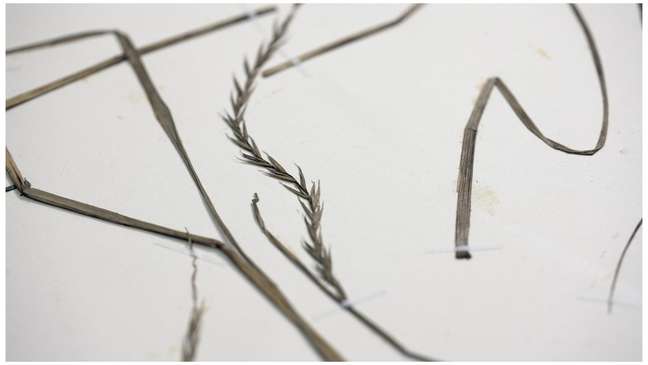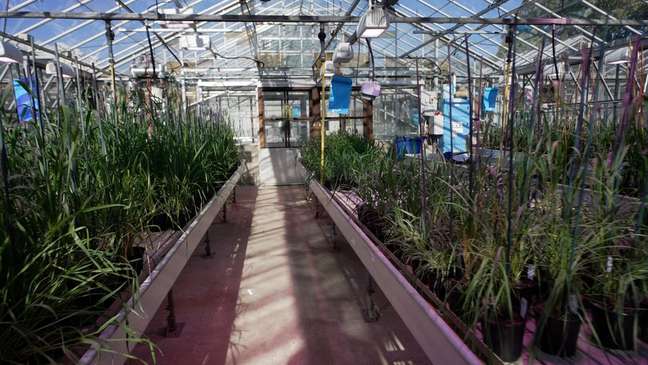The collection of the Natural History Museum is scoured and analyzed for heirloom varieties that grow under the most adverse conditions in today’s world.

Could a solution to powering a warming world be hidden in a 300-year-old museum collection?
This is one of the hopes of scientists who are sifting through 12,000 specimens of wheat and their “relatives” kept in the archives of the Natural History Museum in London, UK.
The most promising specimens are having their genomes sequenced in an effort to identify the genetic secrets of the most resistant varieties.
In addition to pests, climate change has damaged crops around the world.
The centuries-old varieties of wheat are kept in hundreds of old cardboard folders, arranged in rows, in the museum’s basement. Each contains dried leaves, stalks or ears of grain, and in some cases all three, dating back hundreds of years.
All varieties have been carefully labeled, detailing exactly where they come from – essential information for scientists.
“The collection dates back to the 1700s, including a specimen collected from Captain (and British navigator James) Cook’s first voyage to Australia,” Larissa Welton, part of the team digitizing the Natural History Museum’s archive, told the BBC.
James Cook’s sample is wild wheat. It looks spread out and grass-like, quite different from the varieties of wheat grown today. And it is precisely on these differences that scientists have focused.
“We have specimens that date back to before many current agricultural techniques were introduced, so they can tell us something about how wheat grew freely or how it grew before there were artificial fertilisers.”

Why is wheat so important?
Wheat is one of the most important crops in the world: it is used to make everything from bread and pasta to breakfast cereals and sweets, and it is an essential part of our diet.
War in Ukraine, a major grain exporter, has threatened global supplies.
But that’s not the only problem. Climate change is having a growing impact. Scientists estimate that a 1°C increase in temperature could cause a reduction of up to 6.4% in the amount of wheat grown on the planet.
Pests and diseases are also reducing global crop yields by about 20% annually.
In general, modern grain crops have had a hard time. The Green Revolution of the 1950s and 1960s steered farmers towards varieties that could produce more grain, but the quest for higher yields sidelined other varieties, including those that can better handle extreme climates. That is, the diversity of grain today is less.
“We want to find out if there are things we’ve lost that we can bring back to modern varieties,” says Matthew Clark, a geneticist at the Natural History Museum.
And this is important: the world will need about 60% more wheat to feed a growing population by 2050. Hence the search for varieties that can grow in places where there is no planting today or that can withstand to changing environments.
“For example, by looking at crops that have managed to survive in more marginal areas — places with hot, dry climates — we can help more developed countries increase their food production,” says Clark.
He explains that this can be done through traditional breeding, gene modification, or gene editing (a technique where genes can be specifically added, removed, or replaced).

Scientists at the John Innes Center in Norwich (England) are also “hunting” for grain samples.
The center’s archive has 100-year-old samples and contains strains from around the world. The samples are stored at 4°C, so that the seeds remain viable, i.e. so that they can be planted and able to grow.
“What we want to do is look for new and useful genetic varieties,” explains scientist Simon Griffiths, analyzing the collection. The research, he says, is “resistance to disease and stress, higher yields and more efficient use of fertilizers.”

John Innes’ team takes older varieties and crosses them with more modern ones. Some tests have been successful.
“There is a serious disease in wheat called yellow rust. It is a global problem that is increasingly difficult to control,” Griffiths points out.
“Within that collection of ancient grains, there are some (varieties) that are resistant to this disease, and this is currently being considered by farmers to guard against this significant threat to grain production.”
The team is also interested in finding more nutritious wheat varieties.
“What about the nutritional content of the grain? We know that we can increase the fiber and mineral content of the grain,” adds the scientist.
“There’s so much diversity that hasn’t been fully explored yet by modern wheat farmers. We think we can bring it to them.”
In the future, the grain that humanity grows will have to change. Perhaps the answers to finding the best variety of wheat are in the past.
– This text was published in https://www.bbc.com/portuguese/geral-63770939
🇧🇷The best content in your email for free. Choose your favorite Terra newsletter. Click here!
Source: Terra
Camila Luna is a writer at Gossipify, where she covers the latest movies and television series. With a passion for all things entertainment, Camila brings her unique perspective to her writing and offers readers an inside look at the industry. Camila is a graduate from the University of California, Los Angeles (UCLA) with a degree in English and is also a avid movie watcher.




-ubrgialfr7sh.jpg)

